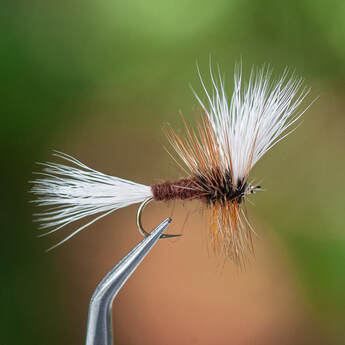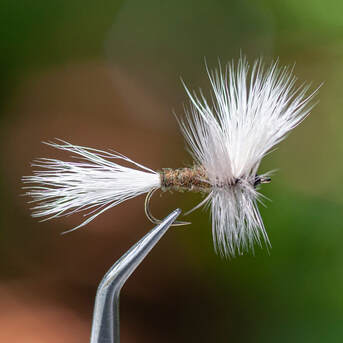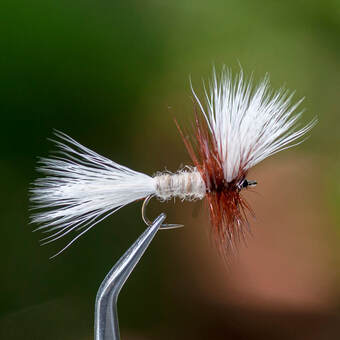Fly of the Month 05.20
Many hair wing fly patterns utilize calf tail or kip tail hair fibers for the wings. In bright colors calf tail hair is highly visible as well as highly floatant. In the late 1930s, Lee Wulff saw the value in tying hair wing fly patterns for Atlantic salmon as well as trout. He first created the Gray Wulff using elk hair, then later the White Wulff and Royal Wulff using calf tail for the upright and divided wings. Wulff preferred to use moose mane hair for the tails, providing a more realistic, long, sparse tail for his fly patterns. Wulff created the Gray Hair Wing, White Hair Wing and Royal Coachman Hair Wing originally as dry flies for Adirondack trout in 1929 and on large hooks for Atlantic salmon in Nova Scotia soon after. Wulff called his flies the Gray Hair-Wing, White Hair-Wing and Royal Hair-Wing as he pursued Atlantic salmon. In 1939, Dan Bailey successfully renamed and marketed these fly patterns as the Gray Wulff, White Wulff and Royal Wulff when tied in the smaller sizes as an adaptation for the pursuit of trout. These names prevailed, regardless of size and use and many additional fly patterns have since then been labeled a “Wulff” of some sort
The group of hair wing fly patterns are designed in general for roughwater and to suggest a mayfly or other upright wing insects as well as caddisfly or stonefly or other down wing insects. A mayfly wing is tied upright and divided using hair fibers or an appropriate synthetic, hair-like substitute. A caddisfly wing is tied downwing or tentwing and a stonefly wing is tied downwing or flatwing using hair fibers or an appropriate synthetic, hair-like substitute. The tail is typically tied using hair fibers and typically omitted for the caddisfly. Body color is typically the basis for the fly name. Hackle is tied to be bushy or palmered, providing a high-float presentation. The Comparadun, Haystack, No Hackle and similar fly patterns are exceptions to the hair wing fly pattern group as they are designed for surface film presentationin in calm water and without the use of hackle.
Origin and History of the Riffle Fly Pattern:
The signature design of the highly visible, high floating Riffle fly pattern is the implimentaion of calf tail for both the upright, oversized wings and the bushy tail, thus, grouped with hair wing fly patterns. The Riffle fly pattern was created by Dick Surette for fast or broken water of the Saco River. Intended for big brown trout during the evening rise. In his book, Dick Surette's Trout and Salmon Fly Index (1974), Dick Surette introduces the Riffle fly pattern based on the Gray Riffle and notes additional ginger, brown, black and cream versions of the series. In his book, The Book of Fly Patterns (1987), Eric Leiser presents the Brown Riffle and The Grizzly Riffle among his compilation of 1000 fly patterns. The original Riffle flies are nothing more than versions of Wulff form and style flies, tied in a combination of basic mayfly colors. The Riffle fly pattern has series evolved as a specialized, calf tail fly pattern from the Wulff fly pattern series. The name "riffle' was coined by Dick Surette, and, as the name implies, the flies are used in fast or broken water. The white wing, hackle and tail tied slightly oversize assure the angler of higher visibility, especially at dusk. First tied in 1964, these flies float extremely well, most of the series tied with fur bodies and a longer hook that will support heavy hackling. Most effective on riffle runs and broken water whrer trout will feed just prior to sunset as they move into their feeding stations. This is a durable, good floater that can be seen well after sunset and you can follow the fly as it approaches the fish. They are carried in the North Country Angler's catalog.
Generational Evolution
As Tom and I have developed additional Riffle fly patterns, the Riffle signature design and the Wulff fly pattern influence are fully maintained. The additional fly pattern designs are also influenced by the hair wing Rattler fly pattern which utilizes palmered brown and grizzly hackle and the hair wing Cory's Calftail fly pattern which utilizes palmered hackle and calf tail fibers for the tail. These high floating fly patterns are both considered adopted Southern Appalachian fly patterns and technically the Cory's Calftail is a palmered, Riffle fly pattern by design but not in name. Fly patterns utilizing a palmered hackle body are some of the earliest designs. The bivisible fly pattern is one of the earliest and simple palmered dry fly patterns. Palmer fly patterns are considered to be literally be among the ancient fly patterns, dating back to the late-1400s. Both palmer and bivisible fly patterns were of great inflence in assuring that each additional Riffle fly pattern created were equipt with high floating capabilities. The 1/2 palmered body is signature for the Adams and Baker versions of the Riffle fly patterns:
Similar or Related Fly Patterns
Many hair wing fly patterns may be considered to be similar or fly patterns of which the Riffle fly pattern was derived in some manner. The Comparadun, Elk Hair Caddis, Goofus Bug, Humpy, Rat-Faced McDougal, Stimulator and Water Walker fly patterns are less similar due to their unique designs. The following is a representative list of similar or related fly patterns.
The original Riffle series:
Dark Riffle Ref: Eric Leiser, Dick Surette
Grizzly Riffle Ref: Dick Surette, Fabri-Mouches
Light Riffle Ref: Eric Leiser, Dick Surette
Cory's Calf Tail Ref: Roger Lowe
The evolved Riffle series: Alen's Riffle, Black Riffle, Blackbird Riffle, Brown Riffle, Cream Riffle, Dark Riffle, Emu Riffle, Ginger Riffle, Golden Riffle, Gray Riffle, Green Riffle, Grizzly Riffle, Light Riffle, Lime Riffle, Olive Riffle, Orange Riffle, Peacock Riffle, Pearl Riffle, Pink Riffle, Ruby Riffle, Silver Riffle, Smoky Mountain Riffle, Tom's Riffle, White Riffle, Yellarhammer Riffle, Yellow Riffle and Cory's Calf Tail.
Dark Riffle
Grizzly Riffle
Light Riffle
Fly of the Month 05.20
Tom Adams and Alen Baker
References:
Leiser, Eric. The Book of Fly Patterns, 1987.
Many hair wing fly patterns utilize calf tail or kip tail hair fibers for the wings. In bright colors calf tail hair is highly visible as well as highly floatant. In the late 1930s, Lee Wulff saw the value in tying hair wing fly patterns for Atlantic salmon as well as trout. He first created the Gray Wulff using elk hair, then later the White Wulff and Royal Wulff using calf tail for the upright and divided wings. Wulff preferred to use moose mane hair for the tails, providing a more realistic, long, sparse tail for his fly patterns. Wulff created the Gray Hair Wing, White Hair Wing and Royal Coachman Hair Wing originally as dry flies for Adirondack trout in 1929 and on large hooks for Atlantic salmon in Nova Scotia soon after. Wulff called his flies the Gray Hair-Wing, White Hair-Wing and Royal Hair-Wing as he pursued Atlantic salmon. In 1939, Dan Bailey successfully renamed and marketed these fly patterns as the Gray Wulff, White Wulff and Royal Wulff when tied in the smaller sizes as an adaptation for the pursuit of trout. These names prevailed, regardless of size and use and many additional fly patterns have since then been labeled a “Wulff” of some sort
The group of hair wing fly patterns are designed in general for roughwater and to suggest a mayfly or other upright wing insects as well as caddisfly or stonefly or other down wing insects. A mayfly wing is tied upright and divided using hair fibers or an appropriate synthetic, hair-like substitute. A caddisfly wing is tied downwing or tentwing and a stonefly wing is tied downwing or flatwing using hair fibers or an appropriate synthetic, hair-like substitute. The tail is typically tied using hair fibers and typically omitted for the caddisfly. Body color is typically the basis for the fly name. Hackle is tied to be bushy or palmered, providing a high-float presentation. The Comparadun, Haystack, No Hackle and similar fly patterns are exceptions to the hair wing fly pattern group as they are designed for surface film presentationin in calm water and without the use of hackle.
Origin and History of the Riffle Fly Pattern:
The signature design of the highly visible, high floating Riffle fly pattern is the implimentaion of calf tail for both the upright, oversized wings and the bushy tail, thus, grouped with hair wing fly patterns. The Riffle fly pattern was created by Dick Surette for fast or broken water of the Saco River. Intended for big brown trout during the evening rise. In his book, Dick Surette's Trout and Salmon Fly Index (1974), Dick Surette introduces the Riffle fly pattern based on the Gray Riffle and notes additional ginger, brown, black and cream versions of the series. In his book, The Book of Fly Patterns (1987), Eric Leiser presents the Brown Riffle and The Grizzly Riffle among his compilation of 1000 fly patterns. The original Riffle flies are nothing more than versions of Wulff form and style flies, tied in a combination of basic mayfly colors. The Riffle fly pattern has series evolved as a specialized, calf tail fly pattern from the Wulff fly pattern series. The name "riffle' was coined by Dick Surette, and, as the name implies, the flies are used in fast or broken water. The white wing, hackle and tail tied slightly oversize assure the angler of higher visibility, especially at dusk. First tied in 1964, these flies float extremely well, most of the series tied with fur bodies and a longer hook that will support heavy hackling. Most effective on riffle runs and broken water whrer trout will feed just prior to sunset as they move into their feeding stations. This is a durable, good floater that can be seen well after sunset and you can follow the fly as it approaches the fish. They are carried in the North Country Angler's catalog.
Generational Evolution
As Tom and I have developed additional Riffle fly patterns, the Riffle signature design and the Wulff fly pattern influence are fully maintained. The additional fly pattern designs are also influenced by the hair wing Rattler fly pattern which utilizes palmered brown and grizzly hackle and the hair wing Cory's Calftail fly pattern which utilizes palmered hackle and calf tail fibers for the tail. These high floating fly patterns are both considered adopted Southern Appalachian fly patterns and technically the Cory's Calftail is a palmered, Riffle fly pattern by design but not in name. Fly patterns utilizing a palmered hackle body are some of the earliest designs. The bivisible fly pattern is one of the earliest and simple palmered dry fly patterns. Palmer fly patterns are considered to be literally be among the ancient fly patterns, dating back to the late-1400s. Both palmer and bivisible fly patterns were of great inflence in assuring that each additional Riffle fly pattern created were equipt with high floating capabilities. The 1/2 palmered body is signature for the Adams and Baker versions of the Riffle fly patterns:
Similar or Related Fly Patterns
Many hair wing fly patterns may be considered to be similar or fly patterns of which the Riffle fly pattern was derived in some manner. The Comparadun, Elk Hair Caddis, Goofus Bug, Humpy, Rat-Faced McDougal, Stimulator and Water Walker fly patterns are less similar due to their unique designs. The following is a representative list of similar or related fly patterns.
The original Riffle series:
Dark Riffle Ref: Eric Leiser, Dick Surette
Grizzly Riffle Ref: Dick Surette, Fabri-Mouches
Light Riffle Ref: Eric Leiser, Dick Surette
Cory's Calf Tail Ref: Roger Lowe
The evolved Riffle series: Alen's Riffle, Black Riffle, Blackbird Riffle, Brown Riffle, Cream Riffle, Dark Riffle, Emu Riffle, Ginger Riffle, Golden Riffle, Gray Riffle, Green Riffle, Grizzly Riffle, Light Riffle, Lime Riffle, Olive Riffle, Orange Riffle, Peacock Riffle, Pearl Riffle, Pink Riffle, Ruby Riffle, Silver Riffle, Smoky Mountain Riffle, Tom's Riffle, White Riffle, Yellarhammer Riffle, Yellow Riffle and Cory's Calf Tail.
Dark Riffle
Grizzly Riffle
Light Riffle
Fly of the Month 05.20
Tom Adams and Alen Baker
References:
Leiser, Eric. The Book of Fly Patterns, 1987.
Riffle Fly
Hook : Dry fly, Tiemco 100 or equivalent size 8,10,12,14. Use of a 2x length dry is also considered a standard
Thread : Uni 8/0 Black or as indicated
Tail and Wings : White calf tail or as indicated
Hackle : Grizzly, or as indicated
The are many representations of this pattern, each with various colors and materials making them unique. The general method of tying remains the same.
Directions :
Hook : Dry fly, Tiemco 100 or equivalent size 8,10,12,14. Use of a 2x length dry is also considered a standard
Thread : Uni 8/0 Black or as indicated
Tail and Wings : White calf tail or as indicated
Hackle : Grizzly, or as indicated
The are many representations of this pattern, each with various colors and materials making them unique. The general method of tying remains the same.
Directions :
- Mount the hook in the vise after debarbing
- Start thread wraps at the hook eye stopping three eye lengths from the eye. Let the bobbin hang.
- Select a good portion of calf tail, slightly smaller than the diameter of a standard pencil. Clean the short hair and soft under fur from the calf tail. Use a fine comb, my is an old mustache comb, to pull the unwanted materials away. The cleaner the better, you will want to avoid bulk when tying in. Tie in the wings at the one third mark using firm wraps with the tips facing the eye while maintaining position on top of the hook shank. Once you have the position make several touching turns heading toward the bend from the tie in. These will be quite firm to establish the location of the wings. Next, make several firm turns directly on the eye side of the calf tail after lifting the calf in order to push the calf to an upright position. You can coax the calf up by pulling to an upright and making the thread wraps hard against the front side of the calf. Make enough turns in the same spot to form a small thread “dam”. Use your thumbnail and push up the calf tail to make it form a fan. If needed add some additional wraps against the calf at this time. Separate the fanned calf into two more or less equal sections and make thread wraps between the uprights to make a more permanent split. Three or four wraps will suffice. Wrap the thread around the base of each side of the wings to tighten up the wing post. Two turns will on each side suffice. Return the thread to behind the wings and cover any calf on top of the hook shank before making touching wraps to the hook bend. There will be a rather large chunk of calf wrapped in thread on top of the hook shank, that is fine, the tailing will even it out.
- Select a smaller portion of calf for the tailing, cut from hide and clean. Even the tips in a hair stacker and when removing, measure the length before placing. The length should be about a hook shank and include sufficient length to reach the stub end of the wings. Tie in on top of the hook shank, once you are happy with the length, using soft wraps starting at the wings and to the hook bend. Once you have two wraps at the hook bend, bring the thread back to the wings in tighter and tighter turns. Wrapping too tightly at the bend will result in the tail flaring. Let the bobbin hang.
- Dub the thread with a thin noodle and begin wraps at the bend, bringing forward to the thorax. Let the bobbin hang.
- Select a rooster hackle of sufficient length to make eight or ten turns and strip a small section of stem of the barbs. Tie in with the shiny side of the hackle facing the eye. Bind securely and advance the thread to the eye and let the bobbin hang.
- Wrap the rooster in tight touching turns to the wings and then in front of the wings, leaving enough space for a head. You should aim for five or six turns behind the wings and four or five in front of the wings.
- Tie off the hackle and trim any waste. Whip finish forming a small head to complete the fly.




